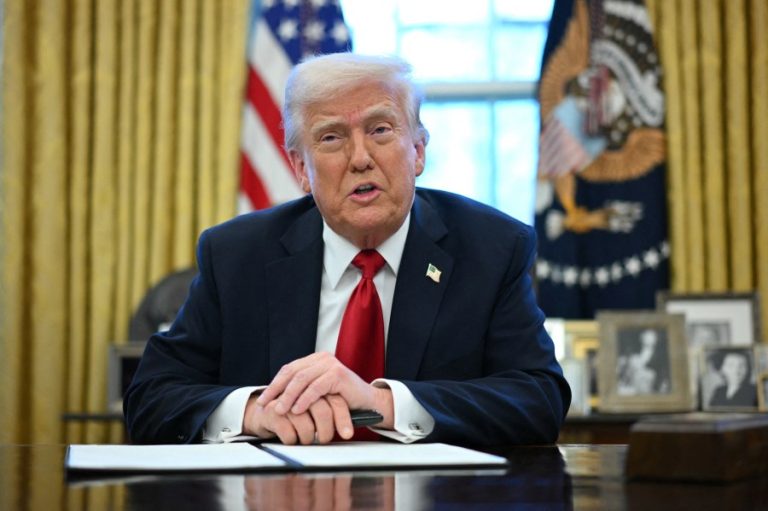WASHINGTON (NewsNation) — President Donald Trump announced a round of self-described “reciprocal” tariffs Wednesday, threatening to unleash a global trade war on what he has labeled “Liberation Day.”
“This is one of the most important day in American history,” Trump said.
Trump announced a 25% tariff on all foreign-made cars starting at midnight. He also said the U.S. would be instituting reciprocal tariffs, including 34% on imports from China (on top of the previous 20%, making it a 54% tariff), 20% on imports from the European Union, 46% on imports from Vietnam, 32% on imports from Taiwan, 24% on imports from Japan, 49% on imports from Cambodia, 10% on imports from the United Kingdom and 30% on imports from South Africa, among others.
4 GOP senators vote with Democrats to undo Trump tariffs on Canada
Roughly 60 countries are being singled out for the reciprocal tariffs, the majority of which are set at half of the tariff those countries place on U.S. goods.
There will be a 10% baseline tariff on all countries where reciprocal tariffs are not specified.
The president repeated his belief that other countries have taken advantage of the U.S. with tariffs and non-monetary restrictions, such as regulations.
Trump maintains that foreign companies will bear the brunt of the fees, but there are concerns that Americans will be heavily affected by the tariffs.
5 takeaways from Trump’s major tariff announcement
“This will be the golden age of America.” Trump said
While the details of the tariff plan are still unclear, the White House’s goals include reducing the flow of fentanyl into the U.S., leveling the playing field with both allies and adversaries, increasing government revenue, and boosting American-made manufacturing.
Among the measures is a proposed 25% tariff on foreign car parts and cars, which Trump believes will boost the U.S. auto industry.
What are tariffs, and why did Trump enact them?
A White House official told NewsNation that the president has instructed American auto manufacturers not to raise prices despite the potential added costs from the tariffs.
Karoline Leavitt, the White House press secretary, told NewsNation on Tuesday that Trump and his trade and tariff team were finalizing the announcement to ensure this is “the perfect deal for the American people.” She added that the tariffs would go into effect immediately.
Tariffs function as an import tax on foreign goods, which American companies often pass on to consumers.
The announcement will take place in the Rose Garden under the theme “Make America Wealthy Again,” at 4 p.m. — after the stock market closes.
UAW backs Trump’s tariff plan
Despite public uncertainty, the Trump administration argues that the tariffs will revitalize American manufacturing by encouraging more companies to establish operations in the U.S., spurring job creation and American innovation.
The United Auto Workers seem to be offering some support for Trump’s tariff strategy. UAW President Shawn Fain told CBS News that while tariffs are a tool to help bring jobs back to the U.S., they’re not the entire solution.
Though the market remains volatile amid uncertainty, Trump points to some early economic wins. Several car manufacturers, including Volvo, Mercedes-Benz and Volkswagen’s Audi, have announced plans to bring some production to the U.S. this year.
How does the automotive supply chain work?
Hyundai plans to build a $5.8 billion steel plant in Louisiana, which will supply resources to its Alabama and Georgia factories, reportedly creating more than 1,300 jobs.
Apple plans to hire 20,000 employees in the U.S. and produce artificial intelligence servers.
Pfizer said last month it might shift some overseas drug production to the U.S. due to the tariffs.
Trump reiterates that his “America First” agenda remains at the core of his tariff policy, aiming to reduce reliance on foreign goods. He has long argued that Americans have been disadvantaged by unfair global trade practices.
How Trump tariffs could impact consumers
The most immediate impact of the tariffs will be felt by consumers.
The Center for American Progress estimates that U.S. households could face an average cost of $5,200 annually. The most immediate price hikes are expected on everyday goods like groceries and gas.
Products like fish, poultry, produce, and dairy, which are imported more regularly than non-perishable items, could see tariffs as high as 25%, potentially raising prices by the end of the week.
Odds of a recession are rising, top economists warn
With tight margins, many retailers cannot absorb these additional costs.
Gas prices are also likely to rise, given that 60% of U.S. crude oil is imported from Canada. Analysts from GasBuddy predict a price increase of 5 to 40 cents per gallon shortly after the tariffs are implemented.
If the tariffs remain in effect for an extended period, consumers can expect higher prices on electronics as well, though many major retailers have already stocked up to minimize the impact on shoppers.
The Anderson Economic Group estimates that levies on parts from Canada and Mexico alone could lead to costs rising from $4,000 – $10,000, depending on the vehicle.
USPS changes begin: How could your mail be affected
Countries affected by this new raft of import taxes are expected to retaliate against the U.S.
Canadian Prime Minister Mark Carney has stated that the country is prepared to respond if the U.S. imposes additional levies on Canadian products, although no details have been provided regarding the timing or extent.
The European Union plans to impose nearly $30 billion in tariffs on U.S. goods later this month.
Meanwhile, Mexican President Claudia Sheinbaum Pardo has indicated that the country will adopt a wait-and-see approach as it prepares for the potential impact of new U.S. tariffs.
Original Trump tariffs led to higher prices
Trump’s previous tariffs during his first term raised prices for American consumers but also led to increased domestic production.
In 2018, he imposed 25% tariffs on steel and aluminum imports, which were reinstated in February this year.
He also escalated tariffs on Chinese goods, which sparked a trade war with Beijing.
Although these moves helped revive certain industries, they also resulted in higher costs for consumers. The steel and aluminum tariffs, for example, boosted U.S. production but also led to higher prices for goods, and ultimately, production declined.
Booker sets record for longest Senate speech in history
Former President Joe Biden maintained the tariffs on China and increased some of them, further contributing to price hikes for American households.
In 2019, the New York Federal Reserve estimated that the trade war with China cost an average American household over $830 each year.
When questioned about the impact of tariffs, a White House official pointed to recent investments from South Korea, Japan, and Qatar in U.S. industries. This is part of the broader aim of Trump’s upcoming tariff announcement on Wednesday.

